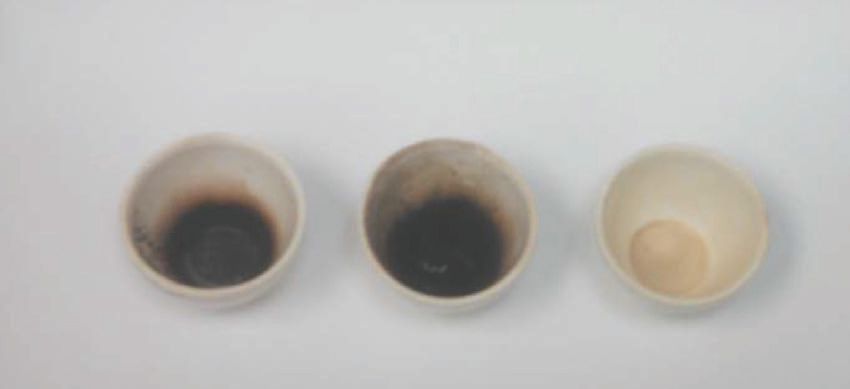Thermally stable ionic liquids
Dr. Neil Canter, Contributing Editor | TLT Tech Beat November 2013
Concern about the thermal stability of currently available ionic liquids led to the preparation of a new type with improved performance.
KEY CONCEPTS
•
The assumption that the thermal stability of ionic liquids is good has been challenged by recent testing.
•
A new series of ionic liquids based on the tetraarylphosphonium cation were evaluated by heating them in porcelain crucibles at elevated temperatures.
•
Four of the five ionic liquids exhibit excellent thermal stability after heating at 350 C for 96 hours.
IONIC LIQUIDS ARE SALTS that can exist in the liquid state. The original definition, as previously noted in this column, is a salt with a melting point below 100 C. James H. Davis, Jr., professor of chemistry at the University of South Alabama in Mobile, Ala., says, “The original definition stating that ionic liquids have melting points below 100 C is arbitrary. Those of us working in the field for a long time understand the definition to include any ionic compound that can be liquefied.”
Though there is the potential to make a large number of ionic liquids from a wide selection of cations and anions, only a few thousand have been prepared and studied, according to Davis. He also considers a past estimate that approximately 400 ionic liquids have been commercialized as a reasonable figure.
Ionic liquids have been evaluated for a number of different applications including as solvents and to facilitate the capture of carbon dioxide. Research also has been underway to evaluate their tribological properties. In a previous TLT article, silver ionic liquids were discussed as possible solvents to separate olefins from paraffinrich waste streams (
1). Promising results were found after using an ionic liquid based on a silver-complexed organic amine cation and a trifluoromethanesulfonyl imide anion to extract the olefins.
One property of ionic liquids that was assumed but never verified is thermal stability at elevated temperatures. Davis says, “Most of the work done to evaluate ionic liquids was at the low temperature end, and while the high-temperature stability of ionic liquids has often been stressed, recent re-analyses suggest that their long-term stability at high temperatures is in question.”
But Davis found quite a lot of variation in the literature on the decomposition temperatures of ionic liquids. He says, “The cation component of an ionic liquid decomposes under elevated temperatures through mechanisms such as beta hydrogen elimination, alpha hydrogen elimination and nucleophilic substitution.”
The vulnerability of most ionic liquids to high temperatures means there is a need for developing a new type with improved stability. Such an approach has led to the development of a more thermally stable class of ionic liquids.
TAP SALTS
Davis and his research associates have developed a series of ionic liquids based on the tetraarylphosphonium (TAP) cation. He says, “We looked at the literature and noted that TAP ionic salts rarely decompose at high temperatures and are more stable than corresponding imidazolium salts.”
A series of TAP salts were prepared by forming a precursor in a metathesis reaction followed by an anion exchange process in water with the potassium salt of [bis (trifluoromethylsulfonyl) imide-Tf
2N]. Besides the base salt, tetraphenylphosphonium, four other salts were prepared that contained variations including an alkyl group side chain, a heteroatom (sulfur) substituent and a phenyl ether substituent.
The researchers decided to compare the thermal stability of these salts by heating them up in porcelain crucibles at elevated temperatures. Davis says, “We noted in the literature that most ionic liquids were evaluated for thermal stability at temperatures between 200 and 250 C. For our study, we arbitrarily picked 350 C, which is 100 degrees higher.”
Samples were run at this temperature for 48 hours with the crucible rotated every 12 hours then cooled, reweighed and heated for another 48 hours. Davis adds, “We needed to rotate the samples to minimize any problems with localized hot spots or unusual air flow dynamics around the crucibles.”
Figure 1 shows the results of the tests for three ionic liquids all containing the Tf
2N anion. One of the TAP salts in the crucible on the right is only slightly changed from its original white color. In contrast, the other two salts prepared with imidazolium and pyrrole cations turned black.
 Figure 1. Thermal stability testing of three types of ionic liquids in porcelain crucibles for 96 hours at 350 C is shown. The ionic liquid on the right barely changed color and is a TAP salt that shows excellent thermal stability as compared to the two other salts that turned black. (Courtesy of the University of South Alabama)
Figure 1. Thermal stability testing of three types of ionic liquids in porcelain crucibles for 96 hours at 350 C is shown. The ionic liquid on the right barely changed color and is a TAP salt that shows excellent thermal stability as compared to the two other salts that turned black. (Courtesy of the University of South Alabama)
Four of the five TAP salts showed excellent thermal stability with the remaining salt prepared with an alkyl group turning into a brown solid. Davis says, “The alkyl group can readily form radicals that will cause thermally induced polymerization, leading to the darkening. In contrast, the other TAP salts can only form aryl radicals that are very stable.”
The researchers found that the four TAP salts displayed very low weight loss (less than 4.3 percent) and exhibited NMR spectra that were unchanged after being heated for 96 hours at 350 C.
One of the challenges in working with most of the TAP salts is they exhibit melting points in excess of 100 C. The TAP salt prepared with the phenoxy ether group does have a melting point of 8 C.
Davis believes that further work should be done to see if the TAP salts can be used as heat transfer fluids since their thermal stability is comparable. Work is now underway to evaluate the TAP salts in a muffle furnace in an effort to obtain absolute thermal stability values. Davis reports, “We have started by determining that the base salt displays good thermal stability in a muffle furnace after heating for 120 hours at 350 C.”
Further information on this work can be found in a recent article (
2) or by contacting Davis at
jdavis@southalabama.edu.
REFERENCES
1.
Canter, N. (2011), “Silver Ionic Liquids: Potential New Solvents,” TLT,
67 (8), pp. 12-13.
2.
Cassidy, C., Mirjafari, A., Mobarrez, N., Strickland, K., O’Brien, R. and Davis, J. (2013), “Ionic Liquids of Superior Thermal Stability,”
Chemical Communications,
49 (69), pp. 7590-7592.
 Neil Canter heads his own consulting company, Chemical Solutions, in Willow Grove, Pa. Ideas for Tech Beat items can be sent to him at neilcanter@comcast.net
Neil Canter heads his own consulting company, Chemical Solutions, in Willow Grove, Pa. Ideas for Tech Beat items can be sent to him at neilcanter@comcast.net.